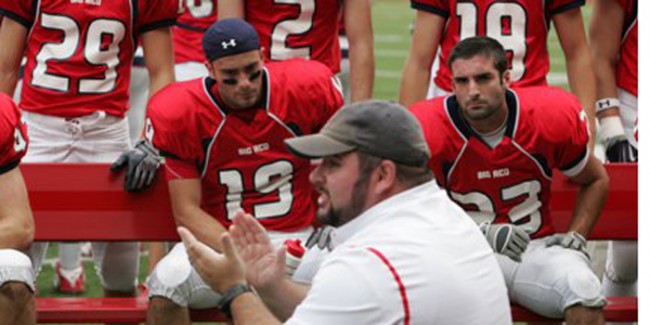
Football is one of the most difficult sports to program for during the season. The physicality of the game, the injury potential, and the overall dependance on speed, strength, and power for success, all make physical preparation a must during this crucial time. There are always questions about intensity, volume, and of course conditioning. The tempo of the game has drastically increased over the last decade forcing strength coaches to adapt along with it.
There are a couple of considerations when implementing an in-season training program for football.
1. SCHEDULING LIFTING TIMES
Try to have strength training session at a different time than practice. I thought having lifting sessions in the mornings was beneficial for readiness for practice and recovery. There is nothing worse for a football player then to lengthen the time they are at practice by adding a training session at the front or back end. Having an entire team come in to train immediately after practice has always been difficult to generate enthusiasm.
If you cannot avoid training your team in conjunction with practice then follow these guidelines:
- Try to have the lifting session before practice. This session should be mostly Dynamic Effort and Sub-Max Effort work.
- If there is no other choice than to lift after practice, then that session should be repetition based for hypertrophy.
2. BASE VOLUME OFF PLAYING TIME
Not all of your athletes play the same amount of total plays, total minutes, or total innings. Because of this, it may be beneficial to adjust the total training volume to accommodate. The accumulative stress from playing sports at a high level is stressful enough. Having an inverse relationship between volume of playing time and volume of training is extremely important. Not only do starters take most of the reps in a game, they also take most of the reps at practice. This is why the volume in the weight room should be adjusted as such.
This is a concept I got from John Patrick and Willie Danzer when John was the Head Strength Coach at Youngstown State University. He split his team up into three different groups: Gain, Retain, and Recover (I renamed this our reload group when I was coaching). There is an in-season guide specifically for football provided in this article.
 The total volume of work could be adjusted based on how much an athlete played the previous game. Olympic lifts and dynamic effort movements could generally stay at the same volume for all athletes regardless of playing time. The main (max effort or circa-max effort) movements of the day would be adjusted.
The total volume of work could be adjusted based on how much an athlete played the previous game. Olympic lifts and dynamic effort movements could generally stay at the same volume for all athletes regardless of playing time. The main (max effort or circa-max effort) movements of the day would be adjusted.
- Gain Group Example: Work up to a 3-5 rep max, additional work set with same load, Back-off Set (-10%) for max reps
- Retain Group Example: Work up to a 3-5 rep max, additional work set with same load
- Reload Group Example: Work up to a 3-5 rep max
 Using an auto-regulated system, like the APRE, you can see in the following example of how a typical set and rep progression may happen with a circa-max effort movement using a weight of 300 pounds. For specific parameters on the auto-regulatory protocol is used or how the cluster sets could be implemented; refer to the chart in the previous “readiness” section.
Using an auto-regulated system, like the APRE, you can see in the following example of how a typical set and rep progression may happen with a circa-max effort movement using a weight of 300 pounds. For specific parameters on the auto-regulatory protocol is used or how the cluster sets could be implemented; refer to the chart in the previous “readiness” section.
 There are coaches that use a non-linear prioritization scheme during the season. This conjugated method of training that often utilizes a systematic rotation of exercises can still be implemented with the Gain, Retain, and Reload group protocols. In the example below, variations are used to coincide with the particular groups add stress of their sport participation. Adjustments in volume can be accompanied by variations of exercises to accommodate resistance, limit range of motion, and reduce time-under-tension.
There are coaches that use a non-linear prioritization scheme during the season. This conjugated method of training that often utilizes a systematic rotation of exercises can still be implemented with the Gain, Retain, and Reload group protocols. In the example below, variations are used to coincide with the particular groups add stress of their sport participation. Adjustments in volume can be accompanied by variations of exercises to accommodate resistance, limit range of motion, and reduce time-under-tension.
 As coaches, it is easy for us to get into a rut when it comes to programming for large groups. This is exacerbated with limited staffing, smaller facility size, and lack or pertinent equipment. Hopefully, one of these three outlooks on training can be implemented in your program to give your athletes the best opportunity to succeed individually and as a team.
As coaches, it is easy for us to get into a rut when it comes to programming for large groups. This is exacerbated with limited staffing, smaller facility size, and lack or pertinent equipment. Hopefully, one of these three outlooks on training can be implemented in your program to give your athletes the best opportunity to succeed individually and as a team.
3. INTENSITY
We have used what our players came to know as "Auto-Reg" sets. We adapted a variation of the APRE system and implemented it into our in-season programming. Aside from instituting standardized "return to play" progressions for our injured players, this was the best way to individualize programming in a team setting. For example, if we were working up to a five rep max on the box squat with chains, the athlete's sheet would say 4-6 reps. Each subsequent set would say "Auto-Reg" in place of reps. To make it simple for the Gain and Retain groups, if the athlete got six reps he would increase five percent for the next set, of he got five reps he would keep the same weight, and if he got four reps, he would reduce five percent. Five percent was easier for the athletes to make adjustments in their heads.
Here is a more detailed look:
We all know, as coaches, that an athlete's readiness to train fluctuates daily. Even with advanced recovery methods, adequate sleep, and proper nutrition, athlete preparedness is consistently inconsistent, especially during the season. If you add injuries, CNS fatigue, and the academic stress associated with intercollegiate athletics, there are major fluctuations in rep ranges even for circa-max effort sets.
Auto-regulated training with rep ranges is one of the best ways to elicit the optimal training effect among the widest array of athletes. Regardless of ability, experience, or stress level, using an auto-regulated based systems can benefit each athlete while still promoting competition and a high-effort environment.
 This is just one example of how auto-regulatory sets can be implemented. This particular example is more suited for in-season training due to the lower volume. There are three other examples using static weight, static reps, and descending weight adjustments in this article or in the charts below.
This is just one example of how auto-regulatory sets can be implemented. This particular example is more suited for in-season training due to the lower volume. There are three other examples using static weight, static reps, and descending weight adjustments in this article or in the charts below.
Here are some more examples of auto-regulated sets. These particular examples are more suited for off-season training and have different variables to manipulate.
Auto-Regulatory: Static Weight with Descending Reps
Auto-Regulatory: Adjustable Weight with Static Reps
Auto-Regulatory: Adjustable Weight with Descending Reps
Areas of Concern when using Auto-Regulated Sets
Because of the lower training age, reduced neurological efficiency, and the less-than-optimal inter-muscular coordination of college-aged athletes, a flat loaded system with a two-rep drop off (if the last set was truly maximum RPE) may be better.
Depending on the previous set, the athlete may go up or down in weight for each subsequent set. The advantage of this is the athlete feels empowered to control the next set with each performance. This system can also breed competition among teammates (a much needed entity in team strength training). Also, the adjustments between sets are more user-friendly. Anyone can figure 10% in their head and cut that in half.
There is a chance an athlete could drop weight then add or visa-versa with this system. For the adjustable weight and descending set example, a typical work set protocol could be: 300×6, 315×4, 315×3, 300×4.
There will be more fluctuation in volume between athletes. Athletes being able to perform the higher reps in the range will accumulate much more volume by the end of the work sets. The advantage of this is the athletes able to perform the prescribed reps at the higher end of the range are using a lower percentage of their training maxes and the increase in volume is tolerated. Over four sets, the deviation will be no more than eight total reps.
For a more comprehensive explanation of Auto-Regulation in a Team Setting, check out this webinar.
TRAINING SESSIONS
All sessions would include a pre-habilitation, five way neck, movement prep, and position specific commitment circuits. For a more detailed look at these these pre-session activities, check out this webinar outlining these circuits.
Sunday - Before or after film session
- Overhead Press Variation
- SL Squat or Band TKE
- Horizontal Row Variation
- Swimming Pool Conditioning
Tuesday - Small groups throughout the morning
- Snatch or Throw Variation
- Box Squat Variation
- Glute-Ham Raise Variations
- SL RDL Variation
Thursday - Small groups throughout the morning
Clean or Swing Variation
Bench Press or Board Press Variation
Pull-Up, Chin-Up or Band Pull-Down
Articles by Mark Watts
Olympic Lifting for Athletes: Using Static Holds to Improve Technique
Head Games: Training the Neck to Reduce Concussions
The Fastest Sport on Ice: Things You Don't Know About Bobsled
Tips to Crush the Combine Tests
An In-Season Training Guide for Baseball Pitchers
Individual Training in a Team Setting
Off-Season Training for Football (with 8-Week Program)
What is Really Wrong with Strength and Conditioning
The Last Sports Performance Podcast
Olympic Lifting for Athletic Performance
Sports Performance Coach Education Series
WATCH: How to Find a Strength and Conditioning Job
WATCH: Becoming a Mentor to Young Coaches
WATCH: The Four-Step Coaching Process
WATCH: 5 Strategies to Perform More Work in Less Time
WATCH: Why Communication is Key to a Better Coaching Career
WATCH: A Better Way to Train High School Athletes
WATCH: How to Implement Auto-Regulatory Training in a Team Setting
WATCH: Pre-Workout Circuits to Optimize Training Time and Maximize Performance
WATCH: Hypertrophy Circuits for Athletes in a Team Setting
Coaches Clinics
WATCH: Two Bench Press Mechanical Drop-Sets for Hypertrophy
WATCH: Two Lateral Speed Drills with Bands to Improve Change of Direction
WATCH: Adjusting the Glute-Ham Raise to Optimize Your Training
WATCH: Basic Linear Speed Acceleration Drills in a Team Setting
WATCH: Kettlebell Training for Team Sports

















